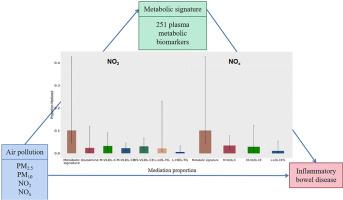Characterizing the mediating role of metabolic signatures in the associations between air pollution exposure and inflammatory bowel disease
IF 3.7
2区 环境科学与生态学
Q2 ENVIRONMENTAL SCIENCES
引用次数: 0
Abstract
The association between long-term air pollution exposure and inflammatory bowel disease (IBD) remains inconclusive. A total of 133,261 participants from the UK Biobank, a prospective cohort were included. Incident IBD cases were ascertained from the administrative database of the National Health Services. Air pollution exposure (PM2.5, PM10, NO2 and NOx) at participants’ residential addresses was estimated by spatio-temporal models. Cox regression models were used to assess the associations between air pollution and IBD. Metabolic signatures were constructed by summing selected plasma metabolites associated with air pollution through elastic net regression. Afterwards, mediation analyses were conducted to investigate the potential mediation of metabolic signatures on the air pollution-IBD associations. During a mean follow-up of 11.61 years (SD: 1.78), 824 incident IBD cases were identified. Long-term exposure to PM2.5, PM10, NO2, and NOx was positively associated with IBD risk: hazard ratios were 1.019 (95 % CI: 0.933, 1.112), 1.033 (95 % CI: 0.942, 1.132), 1.112 (95 % CI: 1.026, 1.227), and 1.121 (95 % CI: 1.028, 1.223), respectively. As PM2.5 and PM10 were not significantly associated with incident IBD, subsequent metabolic analysis was only conducted for NO2 and NOx. The metabolic signatures for NO2 and NOx included 26 and 18 metabolites (mostly related to amino acids, glucose metabolism, and lipid metabolism), respectively. The significant associations of NO2 and NOx with incident IBD were explained by their metabolic signatures (mediation: 10.13 % (95 % CI: 4.56 %, 42.87 %) and 9.17 % (95 % CI: 3.87 %, 38.64 %), respectively). Our findings suggest that long-term air pollution exposure could increase IBD risk, potentially through mediation by metabolic changes.

表征代谢特征在空气污染暴露与炎症性肠病之间的关联中的中介作用
长期空气污染暴露与炎症性肠病(IBD)之间的关系尚无定论。来自英国生物银行的133261名参与者,包括一个前瞻性队列。从国家卫生服务的行政数据库中确定IBD事件病例。利用时空模型估算参与者居住地的空气污染暴露(PM2.5、PM10、NO2和NOx)。采用Cox回归模型评估空气污染与IBD之间的关系。代谢特征是通过弹性网络回归对选定的与空气污染相关的血浆代谢物进行求和而构建的。随后,进行了中介分析,以探讨代谢特征在空气污染- ibd关联中的潜在中介作用。在平均11.61年(SD: 1.78)的随访期间,共发现824例IBD病例。长期暴露于PM2.5、PM10、NO2和NOx与IBD风险呈正相关:风险比分别为1.019 (95% CI: 0.933, 1.112)、1.033 (95% CI: 0.942, 1.132)、1.112 (95% CI: 1.026, 1.227)和1.121 (95% CI: 1.028, 1.223)。由于PM2.5和PM10与IBD发病率无显著相关性,因此后续的代谢分析仅针对NO2和NOx进行。NO2和NOx的代谢特征分别包括26种和18种代谢物(主要与氨基酸、葡萄糖代谢和脂质代谢有关)。NO2和NOx与IBD的显著相关性可以用它们的代谢特征来解释(调解:10.13% (95% CI: 4.56%, 42.87%)和9.17% (95% CI: 3.87%, 38.64%)。我们的研究结果表明,长期暴露在空气污染中可能会增加IBD风险,可能是通过代谢变化介导的。
本文章由计算机程序翻译,如有差异,请以英文原文为准。
求助全文
约1分钟内获得全文
求助全文
来源期刊

Atmospheric Environment
环境科学-环境科学
CiteScore
9.40
自引率
8.00%
发文量
458
审稿时长
53 days
期刊介绍:
Atmospheric Environment has an open access mirror journal Atmospheric Environment: X, sharing the same aims and scope, editorial team, submission system and rigorous peer review.
Atmospheric Environment is the international journal for scientists in different disciplines related to atmospheric composition and its impacts. The journal publishes scientific articles with atmospheric relevance of emissions and depositions of gaseous and particulate compounds, chemical processes and physical effects in the atmosphere, as well as impacts of the changing atmospheric composition on human health, air quality, climate change, and ecosystems.
 求助内容:
求助内容: 应助结果提醒方式:
应助结果提醒方式:


